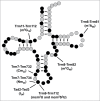Two-subunit enzymes involved in eukaryotic post-transcriptional tRNA modification
- PMID: 25625329
- PMCID: PMC4615748
- DOI: 10.1080/15476286.2015.1008360
Two-subunit enzymes involved in eukaryotic post-transcriptional tRNA modification
Abstract
tRNA modifications are crucial for efficient and accurate protein translation, with defects often linked to disease. There are 7 cytoplasmic tRNA modifications in the yeast Saccharomyces cerevisiae that are formed by an enzyme consisting of a catalytic subunit and an auxiliary protein, 5 of which require only a single subunit in bacteria, and 2 of which are not found in bacteria. These enzymes include the deaminase Tad2-Tad3, and the methyltransferases Trm6-Trm61, Trm8-Trm82, Trm7-Trm732, and Trm7-Trm734, Trm9-Trm112, and Trm11-Trm112. We describe the occurrence and biological role of each modification, evidence for a required partner protein in S. cerevisiae and other eukaryotes, evidence for a single subunit in bacteria, and evidence for the role of the non-catalytic binding partner. Although it is unclear why these eukaryotic enzymes require partner proteins, studies of some 2-subunit modification enzymes suggest that the partner proteins help expand substrate range or allow integration of cellular activities.
Keywords: Tad2; Trm112; Trm61; Trm7; Trm734; Trm8; Trm9; cerevisiae; modification; tRNA.
Figures



References
-
- Hopper AK. Transfer RNA post-transcriptional processing, turnover, and subcellular dynamics in the yeast Saccharomyces cerevisiae. Genetics 2013; 194:43-67; PMID:23633143; http://dx.doi.org/10.1534/genetics.112.147470 - DOI - PMC - PubMed
-
- El Yacoubi B, Bailly M, de Crecy-Lagard V. Biosynthesis and function of posttranscriptional modifications of transfer RNAs. Ann Rev Genet 2012; 46:69-95; PMID:22905870; http://dx.doi.org/10.1146/annurev-genet-110711-155641 - DOI - PubMed
-
- Purushothaman SK, Bujnicki JM, Grosjean H, Lapeyre B. Trm11p and Trm112p are both required for the formation of 2-methylguanosine at position 10 in yeast tRNA. Mol Cell Biol 2005; 25:4359-70; PMID:15899842; http://dx.doi.org/10.1128/MCB.25.11.4359-4370.2005 - DOI - PMC - PubMed
-
- Heurgue-Hamard V, Graille M, Scrima N, Ulryck N, Champ S, van Tilbeurgh H, Buckingham RH. The zinc finger protein Ynr046w is plurifunctional and a component of the eRF1 methyltransferase in yeast. J Biol Chem 2006; 281:36140-8; PMID:17008308; http://dx.doi.org/10.1074/jbc.M608571200 - DOI - PubMed
-
- Mazauric MH, Dirick L, Purushothaman SK, Bjork GR, Lapeyre B. Trm112p is a 15-kDa zinc finger protein essential for the activity of two tRNA and one protein methyltransferases in yeast. J Biol Chem 2010; 285:18505-15; PMID:20400505; http://dx.doi.org/10.1074/jbc.M110.113100 - DOI - PMC - PubMed
Publication types
MeSH terms
Substances
Grants and funding
LinkOut - more resources
Full Text Sources
Other Literature Sources
Molecular Biology Databases
